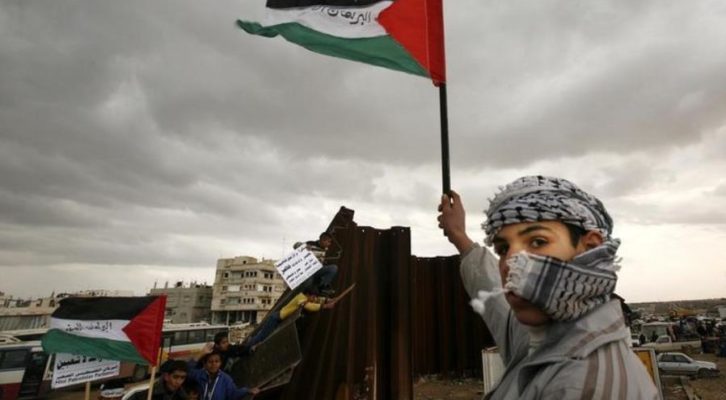Following the latest regional crisis between leading members of the GCC and Qatar, as well as the new political document issued by Hamas, shifts in political tactics and alliances appear to be taking shape within and outside the Gaza Strip. This paper aims to briefly analyze the new political document, the possibility of a Palestinian reconciliation through an Egyptian initiative, and the new developments in the foreign relations of Hamas.
The Document of General Principles: A Pragmatic Move by Hamas
Senior Hamas leaders realized that it was necessary to widen the space available for pragmatic maneuvering. The security closure imposed by Israel and Egypt, the political isolation in the regional and international theaters, the geopolitical upheavals in the Arab world, the prolonged internal Palestinian rift, the cost in human life and damage to property of three military conflicts with Israel have generated growing distress, frustration, and despair in the Gaza Strip and detracted from the organization’s popularity. The fall of the Muslim Brotherhood regime in Egypt in July 2013, the blockade imposed by the GCC countries and Egypt on their main ally Qatar and the damage caused by the 2014 Israeli war on Gaza brought into question the congruence between Hamas’s ideological vision and its ability to cope with the political, economic, and governmental challenges. Although Hamas leaders didn’t change their ideological goals as a result of the group’s difficult situation, however they realized that it was necessary to widen the space available for pragmatic maneuvering. The Document of General Principles of Hamas movement that was announced by Hamas former leader Khaled Mashaal in May 1, 2017 was a main step in Hamas’s pragmatic maneuvering. Several changes in their rhetoric were realized in this document comparing it to their covenant[1]. The new document included more focus on the Palestinian national element and less use of Islamic religious concepts, distinction between the Jews as a religious community and Israel as a state and Zionism as an ideology, and the willingness to accept the establishment of a Palestinian state on the 1967 borders without recognizing the state of Israel. In these changes, Hamas aimed to improved its image regionally and internationally and differs itself from Salafi Jihadist movement that depends only on a violent religious revolutionary vision.[2]
Hamas and Egypt
Sisi’s coup against Morsi’s Muslim Brotherhood (MB) leadership in the summer of 2013 has led to growing tensions between Gaza and Cairo. The Egyptian regime deepened the political and economic isolation of Hamas regarding it as a security threat to Sinai due to Hamas’ relations with MB and its links with Salafi jihadi groups in Sinai by providing them with assistance for attacks against the Egyptian army. The movement of people and goods at the Rafah border crossing was restricted heightening the economic crisis in Gaza. One of the main interests for the Egyptian leadership is the organization’s spacing from the MB’s leadership. The first article of Hamas’s Document of General Principles defines themselves as “a Palestinian Islamic national liberation and resistance movement with their goal to liberate Palestine.” While Islam determines Hamas’s “principles, objectives and means,” the wording chosen reflects a retreat from article 2 of the Hamas Covenant, which defines the organization as a wing of the Muslim Brotherhood movement in Palestine.[3] Some Egyptian analysts described the document as a step for the organization’s willingness to be considered part of the regional and international solution fearing to be the victim of President Trump’s policy against Islamist movement.[4]
Hamas-Dahlan-Egypt and UAE Rapprochement
The regional developments and most notably the GCC-Egypt blockade on Qatar have directly affected Hamas’s political movement. The expulsion of several Hamas leaders from Doha was one of the signs of new political dynamics[5].
Moreover, Abbas hoped to pressure Hamas to surrender their control over the Gaza strip. However, the exiled Fateh leader Mohammad Dahlan rushed to Egypt and brokered an agreement between Cairo and Hamas for an emergency fuel shipment. Dahlan announced a new arrangement for Gaza where he would raise funds for Gaza abroad (mainly by UAE). In return, Hamas would allow his supporters to return to Gaza and operate freely there.[6] For Hamas, an agreement with Dahlan was the only realistic option to avoid launching another war against Israel. Hamas is feeling the effects of the Saudi and United Arab Emirates–led blockade on one of its main allies, Qatar. Dahlan, too, was desperate for a way to remain relevant.[7] The positive security, political, economic effect of this deal emerged quickly. Hamas started taking security measures on the border with Sinai while Egypt repaired the electricity lines from its territory at Hamas’s request.[8] The Hamas-Cairo talks have led to the creation of a 100 meter buffer zone with a length of about 15 kilometers along the Gaza side of the Egypt border. Furthermore, the level of cooperation and Hamas’s willingness to protect the Egyptian border was evident after a Salafi jihadist blew himself up among a group of Hamas border guards on the Gaza-Egypt frontier. The “Jihadi Salafist” group warned the Hamas-led government against harming their “Islamist fighters” attempting to travel into the Sinai.[9]
Dahlan’s close relationship with the UAE reflects the Emirates’ interest in gaining a foothold in Palestine. He is influential in the Emirates where he serves as Crown Prince Sheikh Mohammed Bin Zayed al-Nahyan’s security advisor and is known for his staunch anti-Islamist stances. The UAE’s backing of Dahlan falls under their objective of challenging Qatar’s influence in the region and Gaza is one of the proxy battlegrounds. In spite of Hamas having no intention of abandoning their relationship with Qatar, they are opening up to other Arab states. This attempt to limit Doha’s influence in Gaza is also reflected in the renewed relations with Egypt which controls the vital Rafah border crossing. As a result, Hamas is trying to maintain good relations with Qatar, UAE, and Egypt without taking sides in the ongoing regional conflict. Whether this can be realistically achieved remains to be seen since political conditions may try to be imposed on Hamas by the regional powers competing for influence.[10]
Hamas and Iran
Following the outbreak of the civil war in Syria, Hamas refused to publicly support Assad and as a result, although this did not completely sever the relations with Tehran, but it did lead to a significant drop in military support. Following a change in the Hamas leadership earlier this year and the rise of figures known to be close to Iran such as Saleh Al Arouri, development in the relations with the Iranian axis is expected to intensify.[11] A clear sign is also seen with serious mediation efforts led by Iran and Hezbollah to reestablish good relations between Hamas and the Assad regime.[12]
Internally however, there has been disagreements over whether this is the right step for the movement especially amid improving relations with Egypt. Opposing voices have questioned whether the strategy adopted will eventually lift the siege on Gaza. Some of these voices include more pragmatic figures such as Mousa Abu Marzouk, Ghazi Hamad, and Ahmad Yousef who are considered to be close to Egypt and were very pleased with the recent positive developments in that regard, but they fear that all the efforts made could go to waste.[13]
An anonymous Fatah member and Palestinian security source stated that the publicized re-strengthening of relations with Tehran could be a tactic to improve the deal made with Egypt especially since Hamas cannot afford to upset Sisi due to his control over the Rafah border crossing which is vital to the survival of the movement.[14]
Dahlan’s Aim of Succeeding Abbas
The conflict that has been ongoing between Fatah and Hamas since 2007 was exacerbated when Hamas founded the Supreme Civil Council to administratively manage the Gaza Strip. The council was seen by Abbas as a challenge to the authority of the PA and his position as President. In response, payments for fuel were halted and salaries were suspended to pressure Hamas into the disbanding of the newly formed council.[15]
Taking advantage of the tense pressure-play between both movements, Dahlan, aiming to regain his role as a key player on the political scene, brokered deals as mentioned previously and launched a reconciliation movement.
In response to the headway made by Dahlan, Abbas, who sees this new relationship as a threat to his authority and in an effort to limit the success of his archrival, opened negotiations with Hamas. One of the key initiatives discussed is an equal division of seats in Gaza’s new civil council; however, Abbas is concerned that the Fatah representatives on the council will be loyal to Dahlan which is why he demanded that they be personally selected by him.[16] The tensions between Abbas and Dahlan are reflected with accusations from Fatah members that he sold out to regain influence in the movement.
With Qatar sidelined by the GCC blockade, Abbas stepping down soon, and support from Egypt and the UAE, Dahlan seeks to promote himself as a seeker of Palestinian Unity, even if it cannot realistically happen in the short-term. This boost in popularity is desperately needed by Dahlan due to polls indicating that he is running behind Marwan Barghouti and Ismail Hanieh by significant margins in both Gaza and the West Bank.[17]
Distrust between Hamas and Dahlan
One of the reasons that Dahlan severely lacks in popularity in Gaza goes back to his time as the internal security chief during which he ordered purges against Hamas leaders and members; however, this bad history does not seem to be stopping the cooperation between them. An agreement has been reached where Hamas and Dahlan’s Fatah wing would work together in offering relief assistance and future governance cooperation while Hamas maintains its control over the military and internal security of the area.[18]
The ongoing cooperation between Dahlan and Hamas tends to be unsustainable since extreme circumstances for both sides pushed them into making a deal. Hamas, on one side, seeks to alleviate the hardship of life in Gaza especially amid growing discontent among the population. On the other side, Dahlan needed an opportunity to re-enter the Palestinian political scene after being exiled by Abbas in 2011. On the long-term, both seek to exert control over the entire Palestinian movement which is why their strategic objectives are at odds.[19]
One of the most pragmatic scenarios being projected is that Hamas aims to use Dahlan’s foreign relations to receive external funds from the UAE and Gulf states, as well as establish links with European countries. During this time of “usefulness” of Dahlan for Hamas, he will work on reorganizing and rearming his supporters in Gaza until he feels they are strong enough to assert power. This is coupled with the longstanding and deep resentment among the supporters of both sides due to the bloody history they share.[20]
Possible Rapprochement between Hamas and PA in Gaza
Hamas started negotiations with Fatah, willing to restore a stable situation in Gaza, and to hold general elections in Palestinian territories. This coincided with the dissolving of the Supreme City Council that was formed only a few months ago. The new development occurred following separate talks by Hamas and Fatah representatives with Egyptian officials in Cairo.[21] This was followed by a visit of a huge delegation headed by PA Prime Minister Rami Hamdallah to receive the transfer of administrate power in Gaza from Hamas which reflects seriousness from both sides in pursuing some form of reconciliation.[22]
There has been no commitment on behalf of Abbas to lift the sanctions imposed on Gaza, and the Fatah attitude towards the new moves made by Hamas remains a mix of suspicion and trust. Talks regarding such pressing issues are set to take place soon.
Senior Fatah officials have cast doubt over the chances of an actual reconciliation with Hamas by highlighting that the issue is not simply the disbanding of the administrative body. The issue is much deeper than that and goes beyond the current stage. Questions have been raised regarding Hamas’ response in case Fatah won the elections in Gaza, the future of their armed wing, and whether they will agree to a diplomatic settlement with Israel.[23]
Conclusion
First of all, it seems that Hamas’s leadership is moving the organization steadily in directions to be aware of the popular opinion. For this reason, it needs to strengthen its relations with Dahlan, Egypt, UAE, and even the PA since the movement is financially dependent on the following actors especially after the GCC led blockade on Qatar.
Second, the attempt of Hamas to balance a relationship between the UAE and Egypt on one hand and Iran on the other hand is a tricky task to do especially on the long term as each party will try to impose its own terms on the movement. Maintaining the renewed warmth with Egypt is crucial for passage in the Rafah border crossing as well as having a mediator willing to negotiate with Israel; however, good ties with Iran are also very important from a military perspective if Hamas intends to keep or perhaps alter the military balance of power with Tel Aviv. Failure of building trust between Hamas and Egypt will probably lead to another war with Israel. The military wing of Hamas, which is closer to Iran, in addition to other factions influenced by the Islamic republic (Islamic Jihad), will possibly try to weaken further concessions that will put Hamas in the sphere of influence of Egypt and its allies.
Third, the current leadership of Hamas has maneuvered skillfully, and has successfully caught Abbas and the PA in a trap. Hamas is putting the entire civil responsibility for the residents in the Gaza strip and the entire burden on the PA, without the PA being able to fulfill this responsibility. The result stands to be a decline in Abbas’s status and the legitimacy of his government, and the acceptance of Hamas’s demands constitutes recognition of the organization’s enhanced status as a full, albeit junior, partner of Fatah in the Palestinian government. Moreover, the reconciliation with Fatah is much more complex than the administrative governing of Gaza. A long-term deal would require the agreement on a common vision regarding the means through which Palestinians will continue their struggle against Israel which is unlikely to occur due to opposing views over the best course of action, whether military or diplomacy. This does not rule out the possibility of a basic agreement that can be later built upon.
Fourth, Israel is seeking to maintain its deterrence against Hamas and prevent the next round of violent conflict, or at least delay it for as long as possible. In addition to defense measures, such as building a new barrier along the Gaza Strip border. In the meantime, Israel is unlikely to interfere in the Egyptian reconciliation efforts and will probably accept concessions to loosen the siege causing humanitarian distress in the Gaza Strip. In turn, this will help improve the population’s welfare and quality of life in an attempt to prevent a new conflict with Hamas. On the other hand, changes in the internal political dynamics in Israel may lead the Jewish state to deviate its policy toward Hamas and Gaza strip.
Fifth, the ongoing reconciliation efforts, as seen with the latest visit of the PA Prime Minister to Gaza, are worth following; however, previous attempts have failed because of disagreements over crucial details. Whether this will be different remains to be seen in the coming weeks and months.
The article was originally published in meirss.org
[1] Sher, G. Michael, K. Ofek,L. (2017). Hamas: Toward Palestinian Reconciliation, or Abdication of Governmental Responsibility? IINS, retrieved from: http://www.inss.org.il/publication/hamas-toward-palestinian-reconciliation-abdication-governmental-responsibility/
[2] Ibid
[3] Hamas, “A Document of General Principles and Policies”, retrieved from: http://hamas.ps/ar/uploads/documents/06c77206ce934064ab5a901fa8bfef44.pdf
[4] Kamal,M.(2017) “How Should We Regard the Hamas Document?” al-Ahram, http://www.ahram.org.eg/NewsQ/593845.aspx
[5] Khoury, J. (2017). Palestinians Confirm: Top Hamas Officials Have Left Qatar at Country’s Request, Haaretz, retrieved from: https://www.haaretz.com/middle-east-news/palestinians/1.793763
[6] Omari,G , Rumley,G. (2017), Is War in Gaza Unavoidable?, Foreign Affairs, retrieved from: https://www.foreignaffairs.com/articles/middle-east/2017-08-22/war-gaza-unavoidable
[7] Ibid
[8] Levy,E (2017), Hamas restores Gaza power to pre-crisis level, Ynet, retrieved from: https://www.ynetnews.com/articles/0,7340,L-5014693,00.html
[9] Almeghari, M. (2017), Hamas faces threat of Salafist jihadists once more, The New Arab, retrieved from: https://www.alaraby.co.uk/english/indepth/2017/8/21/hamas-faces-threat-of-salafist-jihadists-once-more
[10] Cafiero, G. (2017) Can the Quartet Eject Qatari Influence from Gaza, LobeLog Foreign Policy, Retrieved from http://lobelog.com/can-the-quartet-eject-qatari-influence-from-gaza/
[11] Al Mughrabi, N. (2017) After Syria Fall-out Hamas Ties with Iran Restored, Reuters, Retrieved from https://www.reuters.com/article/us-palestinians-hamas-iran/after-syria-fall-out-hamas-ties-with-iran-restored-hamas-chief-idUSKCN1B81KC
[12] Abou Amer, A. (2017) Hamas Hints to Return of Relations with Syrian Regime and Iran Offers Mediation, Al Monitor, Retrieved from http://www.al-monitor.com/pulse/ar/contents/articles/originals/2017/08/palestine-hamas-relations-syria-regime-iran-mediation.html
[13] Eldar, S. (2017) Hamas’ Dangerous Gamble on Iran, Al Monitor, Retrieved from http://www.al-monitor.com/pulse/originals/2017/08/israel-hamas-gaza-iran-rapprochement-egypt-military-wing.html
[14] Eldar, S. (2017) Hamas Finds Itself at Egypt’s Mercy, Al Monitor, Retrieved from http://www.al-monitor.com/pulse/originals/2017/09/israel-hamas-iran-egypt-ismail-haniyeh-abdel-fattah-al-sisi.html
[15] Eldar, S. (2017) How Abbas’ Spite for Dahlan Could Reconcile Fatah Hamas, Al Monitor, Retrieved from http://www.al-monitor.com/pulse/originals/2017/08/israel-hamas-fatah-mahmoud-abbas-ismail-haniyeh-yahya-sinwar.html?utm_source=dlvr.it&utm_medium=twitter
[16] Suora note 13
[17] Dunne, M. & Walles, J. (2017) Return of the Native, Csrnegie Endowment, Retrieved from http://carnegie-mec.org/diwan/72729?lang=en
[18] Edwards. B (2017), Gaza end game?, Brookings, retrieved from: https://www.brookings.edu/blog/markaz/2017/07/07/gaza-end-game/
[19] Omari, G. & Rumley, G. (2017) Is War in Gaza Unavoidable, Foreign Affairs, Retrieved from https://www.foreignaffairs.com/articles/middle-east/2017-08-22/war-gaza-unavoidable
[20] Ibid.
[21] Al Jazeera (2017) Hamas Agrees to Steps towards Palestinian Unity, Al Jazeera, Retrieved from http://www.aljazeera.com/news/2017/09/hamas-agrees-steps-palestinian-unity-170917050746920.html
[22] Halbfinger, D. (2017) Palestinian Factions Fatah and Hamas Move toward Reconciliation in Gaza, New York Times, Retrieved from https://www.nytimes.com/2017/10/02/world/middleeast/palestinian-fatah-hamas-reconciliation-gaza.html?smtyp=cur
[23] Eldar, S. (2017) Is Hamas Offering too Little too Late, Al Monitor, Retrieved from http://fares.al-monitor.com/pulse/originals/2017/09/hamas-fatah-egypt-gaza-strip-ismail-haniyeh-reconciliation.html








